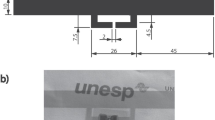Abstract
Radio frequency identification (RFID) is a non-contact automatic identification technology that allows transmission of information and power via radio frequency signals. It has advantages including a short recognition distance, favorable efficiency, and reliable security. Planar antennas are an important aspect of RFID tags, and are usually manufactured by winding, screen-printing, and etching methods. These production processes typically involve thermal/mechanical stresses, chemical corrosion and other manufacturing processes which restrict the choice of substrate. On the other hand, direct writing technology provides a number of advantages, including no restrictions on the substrate, reduced costs, and simplified manufacturing processes. Because of these advantages, we propose a fabrication process for a spiral antenna using direct writing technology of a conductive material. The direct writing system was developed using a dispensing system and a 3-axis stage system. Consequently, a planar spiral antenna for an NFC tag was fabricated. The inductance of the fabricated spiral antenna was in good agreement with the designed value.
Similar content being viewed by others
References
A. M. Niknejad and R. G. Meyer, Analysis, design and optimization of spiral inductors and transformers for Si RF IC’s, IEEE J. Solid-State Circuits, 33 (1998) 1470–1481.
Z. Zhang and X. Liao, Micromachined GaAs MMIC-Based Spiral Inductors With Metal Shores and Patterned Ground Shields, IEEE J. Sensors, 12 (6) (2012) 1853–1860.
B. Cook and A. Shamim, Inkjet printing of novel wideband and high gain antennas on low-cost paper substrate, IEEE Trans. Antennas Propag., 60 (9) (2012) 4148–4156.
L. Yang, A. Rida, R. Vyas and M. Tentzeris, RFID tag and RF structures on a paper substrate using inkjet-printing technology, IEEE Trans. Microw. Theory Tech., 55 (2007) 2894–2901.
M. K. Kim, I. H. Lee and H. Y. Cho, Fabrication of planar type inductor by direct writing, Proceedings of KSME Spring Conference (2014) 1–2.
I. H. Lee, J. H. Kang, T. J. Ko and H. C. Kim, Pattern fabrication characteristics in direct writing of conductive material, Proceedings of KSPE Spring Conference (2011) 649–650.
S. T. Oh, I. H. Lee and H. Y. Cho, Fabrication characteristics of conductive materials for the flow rate and nozzle moving speed, Journal of Industrial Science and Technology Institute, 27 (1) (2013) 1–4.
S. T. Oh, S. H. Jang, I. H. Lee, H. C. Kim and H. Y. Cho, 3-dimensional circuit device fabrication for improved design freedom based on the additive manufacturing, J. Korean Soc. Precis. Eng., 31 (12) (2014) 1077–1083.
J. Chen, On-chip spiral inductor/transformer design and modeling for RF applications, Ph.D. Thesis, Department of Electrical Engineering, University of Central Florida (2006).
F. W. Grover, Inductance calculations, Van Nostrand, Princeton, New Jersey (1946), Reprinted by Dover Publication, New York, N.Y. (1962).
H. M. Greenhouse, Senior member, design of planar rectangular microelectronic inductors, IEEE Transactions on Parts, Hybrids, and Packaging, PHP-10 (2) (1974).
Y. S. Choi, Fabrication and modeling of three dimensional monolithic micro solenoid inductor, Ph.D. Thesis, Department of Electrical Engineering, Korea Advanced Institute of Science and Technology (1998).
ST Microelectronics, AN2866 Application Note: How to Design a 13.56 MHz Customized Tag Antenna, http://www.ebvnews.ru/doc/AN15284.pdf (2009).
Author information
Authors and Affiliations
Corresponding author
Additional information
Recommended by Associate Editor Keun Park
Yu-Quan Bai received a B.E. degree of Mechanical Engineering from Yanbian University, China in 2012, and is currently pursuing a Master of Engineering degree at Yanbian University, as well as a master’s degree in Mechanical Engineering at Chungbuk National University.
In Hwan Lee majored in mechanical engineering and graduated from Sung Kyun Kwan University in 1990, and then, he completed a master’s degree from the same university in 1992. Then he completed a Ph.D. at POSTECH in 2003. Currently, he is a professor at the Chungbuk National University.
Rights and permissions
About this article
Cite this article
Bai, YQ., Kim, MK., Lee, I.H. et al. Fabrication of a planar spiral antenna using direct writing technology. J Mech Sci Technol 29, 2461–2465 (2015). https://doi.org/10.1007/s12206-015-0542-y
Received:
Revised:
Accepted:
Published:
Issue Date:
DOI: https://doi.org/10.1007/s12206-015-0542-y




